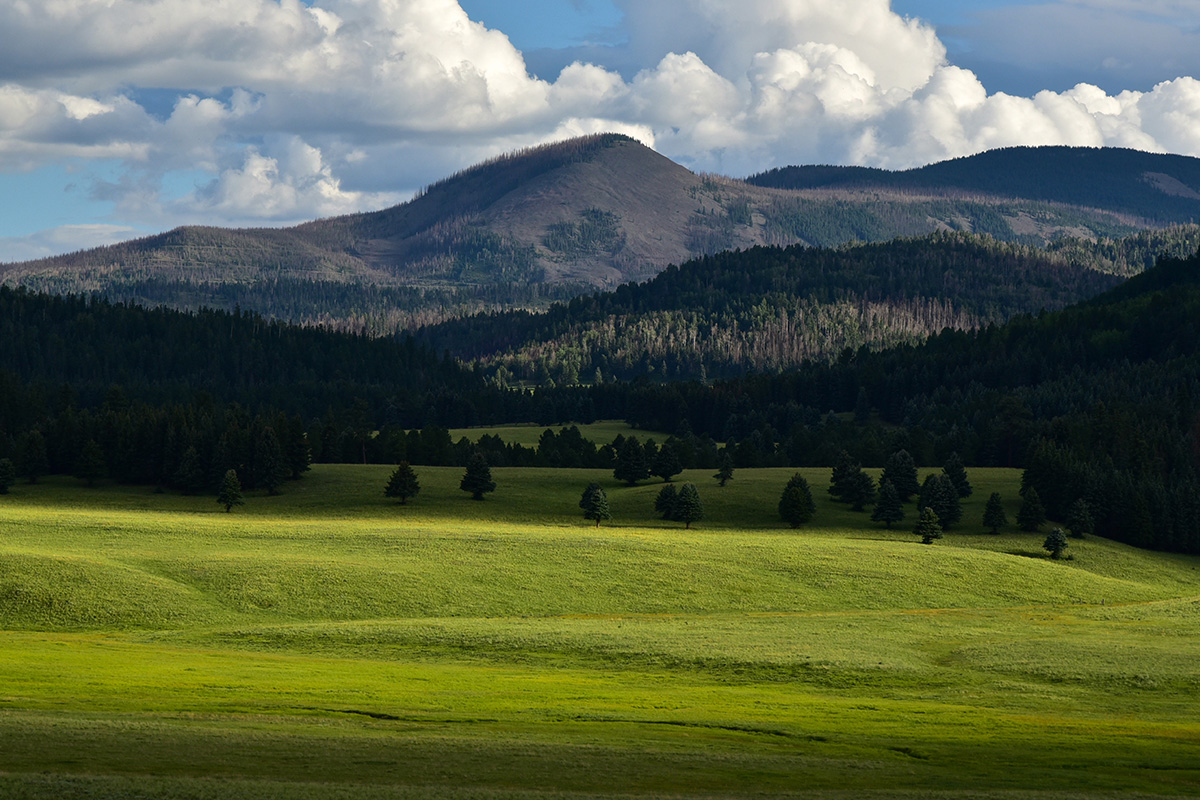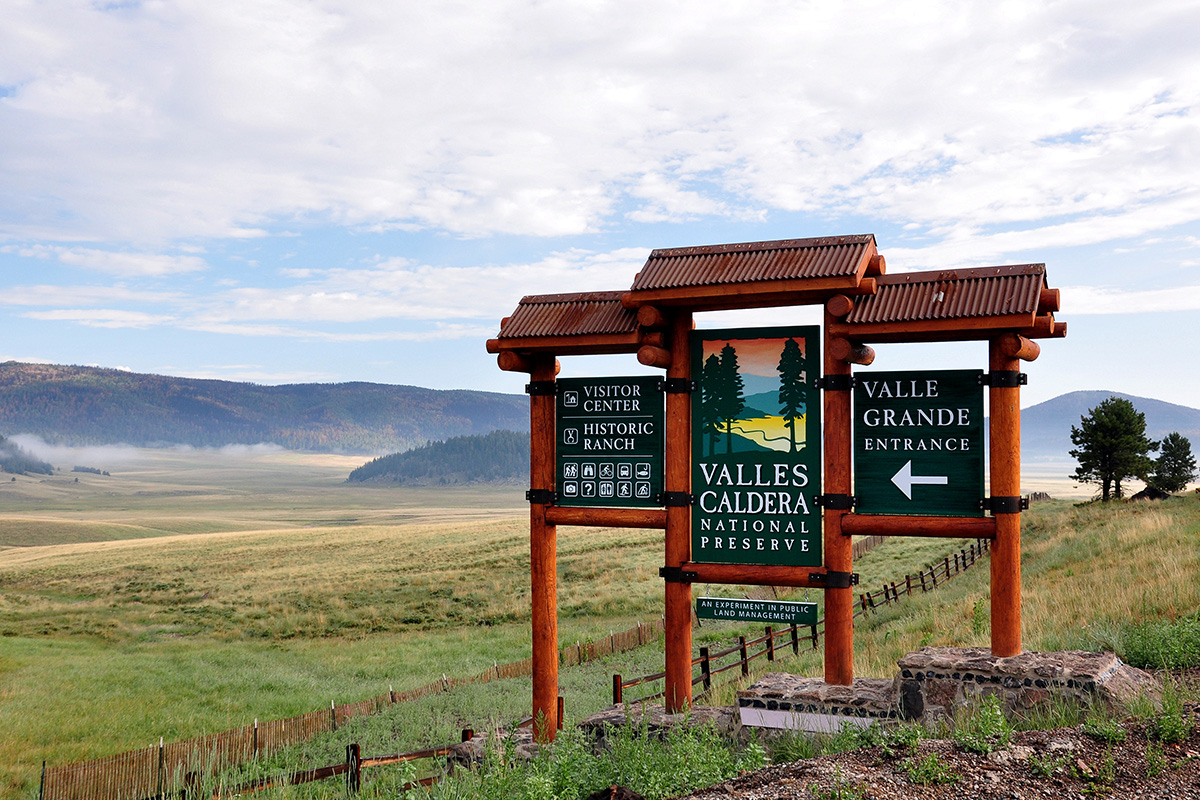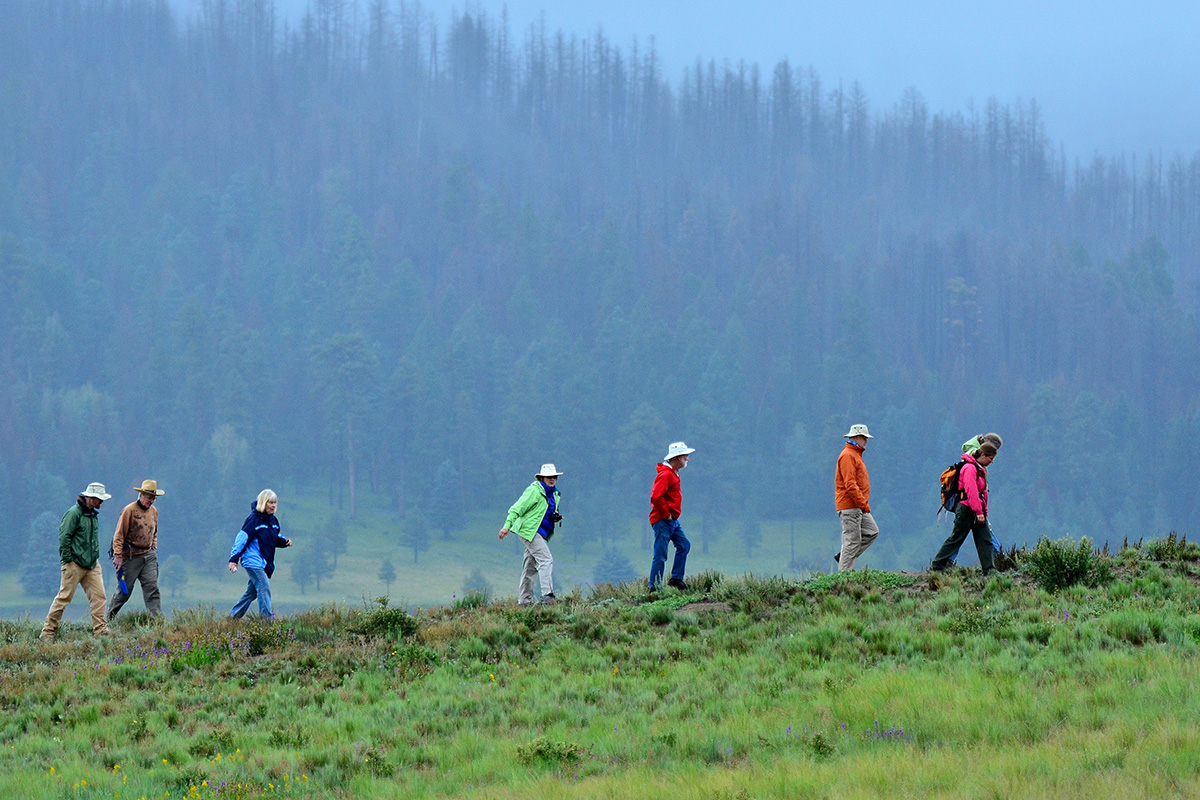As any westerner will tell you, federal lands are a source of immense controversy. Ryan Zinke, the former Montana congressman now serving as Secretary of the Interior, has recognized the need to defuse much of that controversy by looking for ways to improve public land management across the 640 million acres under federal ownership. (See page 14). In particular, he has voiced his support for innovative ideas. “One-size-fits-all often fits no one,” Zinke said in a speech to Interior Department employees in March.
One place the secretary might look for lessons in innovative land management is the Yellowstone-like wonderland in northern New Mexico called the Valles Caldera. Encompassing more than 139 square miles of high country in the Jemez Mountains, the Valles Caldera’s vast and beautiful landscape is famous for its towering ponderosa pines, unique geological features, abundant trout, and thousands of elk. It is also the site of one of the largest and most ambitious public land management experiments in the United States. After nearly 15 years, however, the experiment recently ended in what many have characterized as a failure.
The Valles Caldera was widely seen as a test case for a more financially driven, market-based approach to public land management. The effort was described in these pages in 2004 as a possible new paradigm for federal lands—one that might afford its managers more of the flexibilities of a private-land manager while still remaining public land.
In this article, we summarize several lessons learned from the Valles Caldera experiment. We argue that the preserve did not become the test case for financially driven management that many thought it would be. Various laws and regulations, including the preserve’s own enabling statute, hampered its success and ultimately prevented the trust that was instituted to manage the preserve from living up to those expectations. Instead, it operated in a sort of public land purgatory—neither wholly public nor private, and granted few of the practical benefits of either a privately run corporation or a public land agency. The story of the rise and fall of the Valles Caldera National Preserve provides helpful lessons—if not a cautionary tale—in how to proceed with new and innovative land management models, one that is particularly useful for today’s public land debates.
‘Something New and Different’
Back in 2000, Congress passed the Valles Caldera Preservation Act, creating the Valles Caldera Trust as a new type of federal land management entity based on a fiduciary trust model. The trust was created to manage an 89,000-acre property—formerly known as the Baca Ranch, which had recently been acquired by the federal government to manage as a preserve—as an alternative to traditional park and forest management. Although the federal government would own the land, the Valles Caldera Trust would manage the property, governed by an autonomous, diverse board of directors instead of a federal agency. The preserve was to be managed according to the principles of multiple use and sustained yield, like other federal lands, but the Valles Caldera Preservation Act also included a unique mandate that the preserve become financially self-sustaining by 2020.
In the beginning, there was hope that the experiment could circumvent some of the political deadlock, stagnation, and litigation that are common on federal lands. Larry Gess, who conducted research on public administration of the trust during its early years, noted a sense of optimism that the experiment presented an opportunity to reexamine traditional public land management. “The clear majority of people interviewed expressed their belief and hope that the Valles Caldera National Trust can represent something new and different,” he wrote. “Importantly, they feel the conversation can be moved from that of environment versus economic opportunities, to one in which environmental protection, wise natural resource use, and economic progress can be accomplished.” Moreover, the emphasis on financial self-sufficiency came from former U.S. senator Pete Domenici and other conservatives with the idea public lands could and should be able to pay for themselves.
The Valles Caldera operated in a sort of public land purgatory—neither wholly public nor private, and granted few of the practical benefits of either a privately run corporation or a public land agency.
In practice, despite efforts to entrust the management of the preserve to an autonomous board instead of a myriad of planning rules and regulations, the trust still bore many of the same costly regulatory and bureaucratic burdens as other federal lands while enjoying few of the advantages of a corporate board-run entity. In the end, these and other obstacles hampered the trust’s ability to deliver on its initial promises. The experiment ended in December 2014 when President Barack Obama signed legislation transferring management of the preserve to the National Park Service.
Government or Corporation?
Many of the trust’s challenges stemmed from its dual identity as a government and a corporate board-run entity, which ultimately prevented the trust from becoming financially self-sustaining. Although the trust model was intended to grant managers more of the flexibilities of a private-sector operator, as a government corporation the trust still faced many of the same compliance duties and statutory requirements that apply to federally owned lands. These included the need to develop assessments of the environmental impacts of proposed activities as required by the National Environmental Policy Act (NEPA), as well as various procedural and auditing requirements under the Government Performance and Results Act and the Government Corporation Control Act. These statutory requirements posed significant problems for the trust—in particular, they hindered its ability to comply with its mandate to achieve financial self-sufficiency.
In fact, early on the trust determined that, despite its Congressional mandate, financial self-sufficiency was not going to be a practical goal, in part due to the cost of complying with federal laws and regulations. In a 2005 report, the Government Accountability Office noted that the Valles Caldera Trust had failed to develop strategic and performance plans, measurable goals and objectives, annual performance reports, and a strategy for self-sufficiency. In response, the trust’s board issued a formal response noting that it was keenly aware of the financial self-sufficiency mandate but that financial sustainability would not be the primary goal for the trust. Instead, it would be one of many management challenges “on par with all of the other provisions” of the trust’s enabling act.
Over time, the trust determined that the cost of compliance with environmental laws should not be included as expenses and, in 2009, recommended to Congress a modification of the goal for financial self-sustainability: Instead of pure financial self-sufficiency, it would work toward a more modest goal of cost recovery for its operational (as opposed to administrative) programs, such as grazing leases and recreational access. Although the self-sufficiency mandate was never statutorily changed by Congress, by the end of the experiment, the trust’s formal interpretation of its financial sustainability goal was to establish “a public-private model of administration to optimize revenues and develop philanthropy to support the preservation, enhancement and operation of the Valles Caldera National Preserve.” Overall, revenue from the trust’s various programs brought in approximately 28 percent of its budget, which came close to cost recovery of its operational programs.
Further complications resulted from a significant leadership vacuum within the trust—one not usually associated with other board-run entities. Not only did the trust experience high turnover of its board of trustees, but it also managed to go through 14 different executive directors over 14 years, with none staying longer than two years. Similar challenges were faced with other key staff positions.
Public use and access for all activities were relatively limited on the preserve due to concerns over liability. When the preserve was acquired, it was in rough shape in terms of both ecology and infrastructure. For example, there were an estimated 1,200 miles of roads and several bridges, most of which were constructed with little planning or engineering. Most of the existing buildings from previous ranching operations were in various states of disrepair, and the existing water treatment facility was not functioning, and as a result the preserve did not have potable water.
Furthermore, the trust’s status as a government corporation raised questions regarding possible liability if any accidents were to occur on the preserve. In particular, it was unclear whether the trust had the authority to purchase insurance and whether it would have access to a “judgment fund,” a source of money federal agencies can use when found liable for damages under the Federal Tort Claims Act.
Ultimately, it was determined that the trust did not have access to the judgment fund, and it was forced to purchase its own liability insurance. This placed a continued, and to some extent unpredictable, stress on its resources. In its 2013 annual report, the trust noted: “As the numbers of visitors and public programs increase, the cost of insurance will continue to consume a larger portion of the trust’s appropriated budget.” From 2007 to 2008, for instance, the cost of insurance doubled to more than $83,000 per year, and eventually rose as a high as $90,000. The trust never had a tort claim filed against it, but its annual report noted that “should the trust’s liability insurance actually sustain a valid claim, it is very likely that private liability insurance would thereafter be either unobtainable or unaffordable.”
Concerns over liability influenced the type and extent of recreational opportunities on the preserve. For example, snowmobiling was never considered as a recreational option because it would have increased insurance costs prohibitively. Trail access for hiking, mountain biking, horseback riding, and other activities were also limited by season, date and time, and location due to liability concerns.
Limitations of the Trust
Another constraint on the Valles Caldera Trust’s capacity to become financially self-sufficient was its inability to engage in contracts beyond the life of the trust experiment. The statute prohibited the trust from entering into leases lasting longer than 10 years. In practice, this created constraints unlike any facing a typical corporation. For example, the trust had the opportunity to purchase the land in Jemez Springs where its administrative offices are located, but its inability to borrow money for the purchase made that impossible. Even more importantly, this provision limited the trust’s ability to attract concessionaires or other long-term business partners, such as Xanterra Parks and Resorts, which operates lodging and other activities in many national parks.
Perhaps the most limiting aspect of the trust’s design was its relationship to the U.S. Forest Service. The trust’s enabling act placed it as a unit within the National Forest System but separate and apart from the Forest Service’s organizational structure, which divides the country into regions. This had two ramifications that impeded the success of the experiment. First, the preserve became a line item in the Forest Service’s annual appropriation request to Congress, and as a result the trust had to compete each year for resources in an already financially strapped agency.
The trust was deprived of some protections enjoyed by federal agencies and some freedoms provided to corporations. One of the lessons to be learned is that it is challenging to be both the government and a corporation at the same time—especially where there is a general expectation of public access and use.
Second, the Forest Service changed its policy on procurement procedures toward the end of the experiment, which undermined the trust’s management flexibility. Originally, the trust’s enabling act explicitly exempted it from time-consuming government procurement regulations and policies. This meant that the trust had the ability to issue its own purchase orders and contracts under its purchasing policies, which were approved by the Office of Management and Budget. For this reason, the trust initially operated with relative autonomy and much more nimbly than most federal agencies. That changed in October 2012, when the Forest Service declared that all trust procurements—contracts, purchase orders, agreements, grants, and small credit card purchases—had to follow Forest Service procurement regulations and policies, despite the language of the statute. As a result, all purchases had to be documented on forms used by the Forest Service and approved by the agency’s procurement office in Albuquerque. Procurements that used to take 24 to 48 hours took weeks to months to be processed, and contracts that were once processed in several weeks now took up to a year to complete.
In short, the trust was deprived of some protections enjoyed by federal agencies and some freedoms provided to corporations. One of the lessons to be learned is that it is challenging to be both the government and a corporation at the same time—especially where there is a general expectation of public access and use.
Adaptive Management
Despite its challenges, the trust did achieve some notable successes. In particular, its early commitment to science-based adaptive management created perhaps the most interesting and positive outcome of the experiment: The management of the Valles Caldera was never the subject of a single lawsuit—a remarkable feat for public land management in the American West, where environmental groups, ranchers, and other interested parties increasingly rely on litigation to influence decisions involving public lands.
One of the unexpected successes from the experiment included its approach to natural resource decision-making. As noted above, the trust was required to comply with NEPA. The trust viewed this as an opportunity to incorporate collaborative process and science-driven management into its decision-making procedures. Because the preserve was essentially starting from scratch, it invested heavily in gathering baseline data—the end product of which was a powerful spatial geodatabase that allowed the trust to quantitatively analyze the existing condition of the preserve and model proposed management scenarios. This baseline data also provided a starting point for monitoring ecological functions over time. In addition, the preserve embraced adaptive management, a process that allows management actions to provide a basis for learning to guide future decision-making.
In 2014, the National Association of Environmental Professionals gave its “Excellence in NEPA” award to the Trust in recognition of its NEPA process for its “Landscape Restoration and Stewardship Plan,” which received only one negative public comment despite its aggressive program for forest thinning, prescribed fire, and other often-controversial forest-restoration programs. As Jorge Silva-Bañuelos, the executive director of the trust during its final years, explained at the time: “Managers from other agencies have asked me how we justify the amount of money we invest in our science programs. I tell them to think about all the money we save in litigation costs.”
Public Lands Purgatory
In the end, the preserve did not become a test case for a market-based approach to public land management. Many obstacles made this unachievable. In some sense, the preserve found itself in public lands purgatory. Instead of getting the best of both public and private management, it got the worst. As a public land unit, it received few of the benefits enjoyed by other public lands, including liability protection and access to the federal government’s judgment fund. Likewise, it received few of the benefits of a corporation, including the ability to enter into long-term contracts and relief from the bureaucratic and regulatory requirements of federal agencies. At the same time, it continued to carry the obligations of being both public and private, including balancing conservation, multiple use, open access, and a need to cover its costs. However, the trust’s approach to collaborative, science-based management reduced conflicts and increased public support for the preserve. In this way, the experiment taught us less about “trust” as a governance model than “trust” as a characteristic of relationships—confidence that builds among stakeholders over time.
If a public lands model could capture that collaboration while addressing the limitations that impaired the trust’s ability to succeed, then the lessons learned at the Valles Caldera might prove valuable for other future innovations in federal land management. Closer attention to liability concerns, along with a recognition that environmental compliance issues like those required by NEPA can be costly and need to be taken into account, would increase the likelihood of success with any similar experiments in the future.
Our public land ethos may be deeply entrenched in our culture and political process, but that ethos, while time honored, should not limit efforts to improve federal land management. As the new interior secretary seeks to encourage creative conservation solutions, he should heed the lessons learned from the Valles Caldera but not let the perceived failure of it deter us from trying new things.







